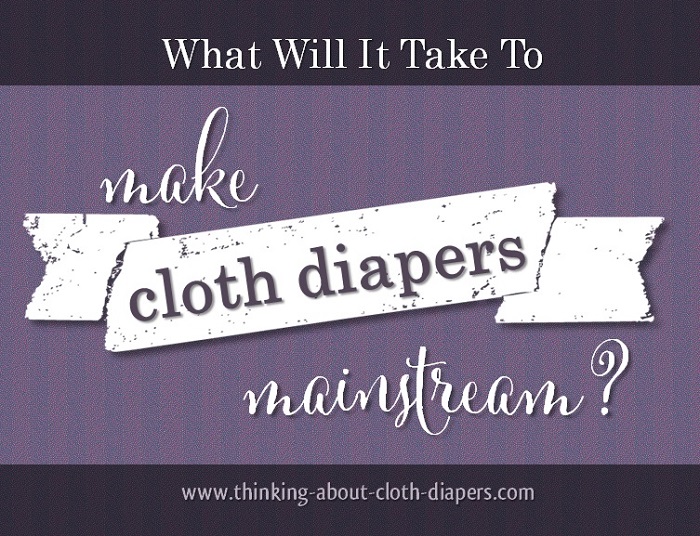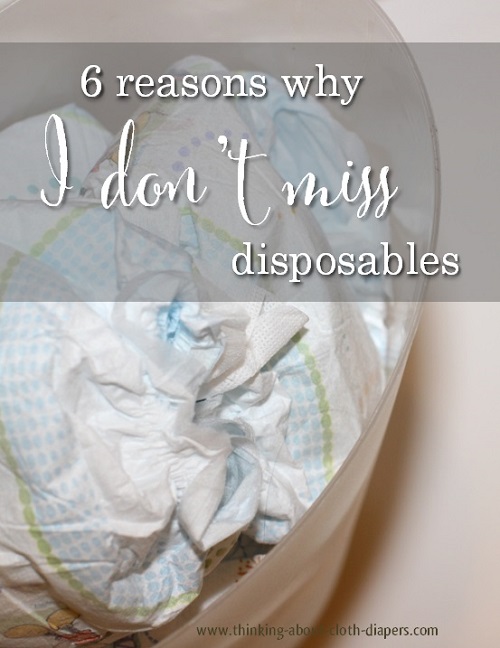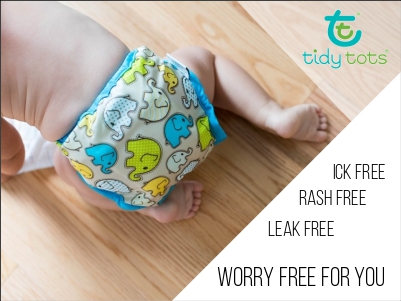Making Cloth Diapers Mainstream:
And Industry in Change
Ten years ago, the cloth diaper industry was in its infancy. Where is it headed today? What lies ahead for cloth diapers?
Introduction
Cloth diapers are commonly acknowledged to reduce environmental impact and ease financial burdens for new parents, yet despite rapid growth over the past decade, cloth diapers are still considered the “unconventional” choice for most new parents. Is that about to change?
Will Cloth Diapers Change the Way we Change Babies?
The question is, will cloth diapers become the mainstream choice, or will they forever remain a “niche” baby product?
Another, perhaps even more important question is who will own the subsequent growth if cloth diapers do make it mainstream? Will it be the existing cloth diaper manufacturers, or the highly opportunistic disposable diaper industry?
Who Will Win?
Obviously, the overall goal for the cloth diaper industry is to increase cloth’s market share of the total baby diaper category. The challenge with the cloth diaper industry is that it is made up of many small cottage-type manufacturers (many with very little experience in marketing) with a few “big” companies. I say “big” in quotes because they would not be considered to be anything beyond “medium” by most business standards.
With tight product margins, small cloth diaper companies lack the financial means to develop sweeping marketing campaigns, and rely primarily on social media and word of mouth marketing, along with a limited retail presence, to get the word out.
Pit that against the market incumbents, a couple of huge multinational disposable diaper manufacturers with incredible industry consolidation. The margins on disposable diapers are significant and the volumes are huge. With the total market declining (the number of babies 2 and under in the US was down about 3% to 8.1 million in 2011 census data), and unit sales reportedly down 9% in Symphony IRI data ending Aug 7, 2011 (source), these companies are already playing a solid defense. Whether cloth diapers, or simply baby changing habits are behind the declining unit sales, companies like P&G (the makers of Pampers) & Kimberly Clark (the makers of Huggies) undoubtedly employ many bright minds to develop the strategies and marketing campaigns to protect their market share.
Marketing Increased Consumer Value
Marketing is going to be the central activity required to #makeclothmainstream.
What exactly is marketing? Well, according to the Charted Institute of Marketing (CIM), marketing is “the management process responsible for identifying, anticipating, and satisfying customer requirements profitably.”
Marketing ≠ Media
So often, when conversations happen about promoting cloth diapers, this is what I hear:
Q - How do we make cloth diapers mainstream?
A - We just need to advertise them on TV and then people will buy them.
In case you weren't aware of it, here's a little newsflash for you - TV just isn't feasible, even for the biggest companies in the cloth diaper industry! First off, do you know how much a 30 second spot costs on prime time? Check here. (That's a LOT of diapers!) Then realize that producing an ad for prime time isn't something you do in a basement studio - it would likely cost you $100,000 or more. Plus, do you even know what soon-to-be parents are even watching these days? It sure as heck isn't commercials. And so one ad on one network really isn't going to reach as many people as you would hope. And last I checked, Netflix was still ad-free!
Multi-Faceted Marketing
Generally, marketing focuses on 4 distinct facets, which are often called “the 4 P’s of marketing”. I work in a consulting role with retailers in the mass and grocery channels, and we use price, promotion, merchandising (which is broader than “place”), and assortment (which is broader than “product”). I also like to believe that there is a 5th “P” to marketing, and that is “people”. The consumer’s needs, whether they can articulate them or not, need to be the focal point of all of the marketing activities that you do.
How can cloth diapers be positioned to appeal to a broader audience?
Reaching New Markets
When you’ve worked in marketing for awhile, you’ll discover that everyone likes to quote Steve Jobs. I’m not going to get cliché and do the same. Instead, I’m going to throw out a quote from Dharmesh Shah, one of the founders of HubSpot, a software company that seeks to transform the way companies market to their target customers. Shah says, “Many companies have forgotten they sell to actual people. Humans care about the entire experience, not just marketing or sales or service. To really win in the modern age, you must solve for humans. Every process should be optimized for what is best for the customer – not your organization."
I too believe that reaching into new markets is all about focusing on the consumer. One way to do that is by solving the existing problems that potential customers already struggle with.
What problems already exist?
A History of Innovation
The cloth diaper industry has already done a bang-up job of solving problems for their current customer set. One-size diapers were introduced after companies realized that customers were pushing back on “sized” diapers. When customers realized that sized diapers weren’t always suitable for newborns, a whole “newborn” size category resulted. FuzziBunz, AppleCheeks and RagaBabe have all looked to tackle diapers for older children. And constant innovation in design and textiles seemingly offers something for everyone.
Yet, the vast majority of parents still put their babies in disposable diapers. Are they completely happy with them? Not likely. Do they see cloth as a more attractive alternative? Obviously not – at least yet. And so, what’s it going to take to win them over?
Marketing Theory
In classic marketing theory, product adoption follows a “product diffusion curve”. Thanks to constant news coverage about technology devices, you may recognize some of the terms on this curve – Innovators (2.5%), Early Adopters (13.5%), early Majority (34%), Late Majority (34%), and Laggards (16%).
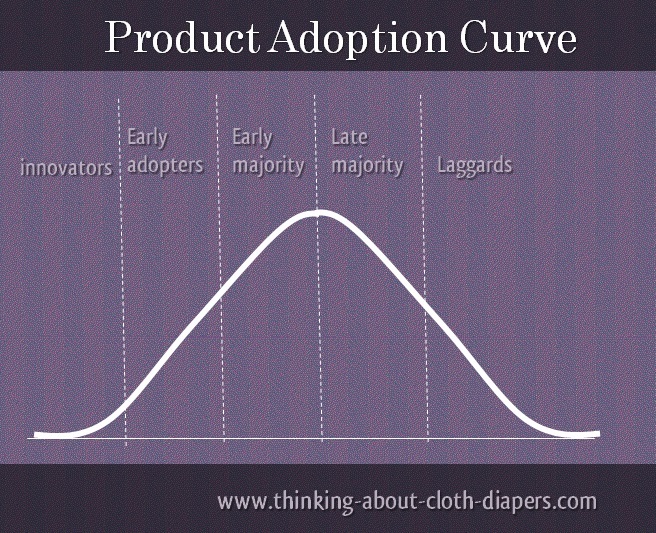
In the early 1990’s, a technology consultant by the name of Geoffrey Moore proposed an update to the standard bell curve. His felt that his experience with product innovation didn’t match the earlier proposed bell curve, because the original theory didn’t account for a gap that he saw happening. He said that there was something that held products back from gaining market share, and that was that the companies that made these products incorrectly assumed that consumers would quickly and easily adopt them. He revised the bell curve to include “the chasm” in his breakthrough book, “Crossing the Chasm: Marketing and Selling Disruptive Products to Mainstream Customers”.
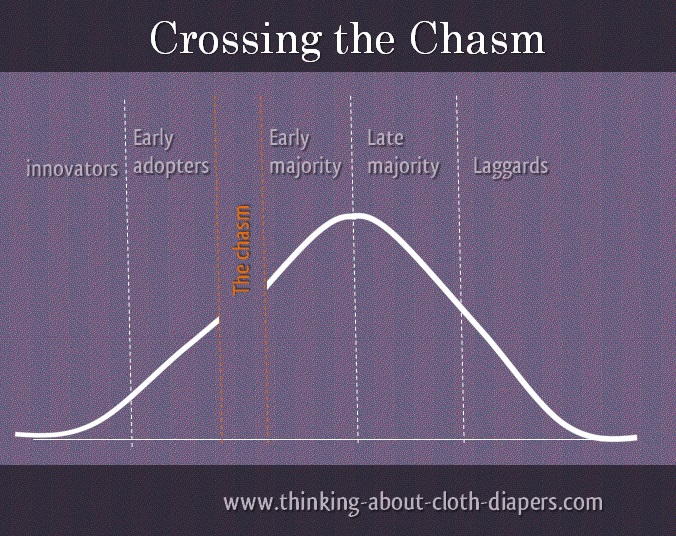
More recently, Malcolm Gladwell’s book “The Tipping Point” suggest an alternative theory to “the chasm”. He throws out the traditional adoption curve, ands suggests that in the modern world, the back half of the traditional bell curve of marketing isn’t relevant. Instead, he says that new products must reach a critical mass, known as “the tipping point”, which he defines as “that magic moment when an idea, trend, or social behavior crosses a threshold, tips, and spreads like wildfire”.
How Do We Go
Mainstream?
Applying the Theory
Whether you believe Moore or Gladwell doesn’t matter. The point behind both of these theories remains similar in that there is a critical effort required to take new products to the mainstream consumer. Between the two theories, we are left with 4 key areas to address that will help extend cloth diapers (and related accessories) to broader markets:
- Pragmatists in Pain (Moore) – buyers are “pragmatists in pain,” stuck with a problem and willing to take a chance on something new, provided it is directly focused on solving their specific use case.
- The Law of the Few (Gladwell) – key people that can endorse and advocate the idea, concept or product.
- The Stickiness Factor (Gladwell) – The specific content of a message that renders its impact memorable.
- Power of Context (Gladwell) – the implications of small variations in social groups and minor changes in a neighborhood or community environment.
Further adding to the challenge is the fact that the parenting period for babies is relatively short. Babies outgrow diapers, and so the new parenting market is one of constant acquisition.
Moving to Mainstream Adoption of Cloth Diapers
While most statistics might suggest that cloth diapers haven’t achieved anywhere near 15% of the diaper market yet, there is no doubt that the leaders in the industry are already developing strategies to bring cloth diapers to the masses. Are you?
Looking again at the 4 points above as they relate to cloth diapers, here are some thoughts and ideas that might help you with your brainstorming!
Pragmatists in Pain
What problems do parents currently have with diapers? How can we solve their problems? Parents have proven time and time again that they will choose what is best for their baby, regardless of cost or other implications, when that product solves their needs. When in doubt, follow the innovations in the disposable industry – they spend millions of dollars on marketing research, analysis, and focus groups to understand where to focus their product development and marketing dollars!
- Skin sensitivity, rashes, and chemical allergies
- Wiggly children who won’t hold still for diaper changes
- Overnight diapers – expense and performance
- Delayed day training
- Bed wetting – actually, this is an area that disposable diaper manufacturer Kimberly Clark, the maker of Huggies, has addressed with the launch of Goodnite Tru-Fit overnight pull-ups in the summer of 2014. These pull-ups consist of a washable and reusable outer shell and attachable absorbent pads that eliminate the disposable pull-up aesthetic that existed with the previously available bed-wetting products. This market doesn’t end there – mattress pads are an extension, too.
Note: To the best of my knowledge, the Tru-Fit launch might be the first foray by a manufacturer of disposable diapers into reusable, cloth products... Where will they go with this next???
Current cloth diaper users have challenges with existing products and may (reluctantly or not) switch from cloth back to disposables. Here are a few key areas where new solutions might bring a larger market share to cloth:
- Heavy wetters
- Overnight diapering woes
- Travel solutions
- Use by daycares, grandparents, and other care providers
- Use by hospitals
When considering solutions, it’s helpful to think outside the box too. Like other areas of our lives, disposable products (example, water bottles) can have a time and place. Consumers have embraced “hybrid” diaper options, which offer a combination of disposable and reusable diaper components, and ultimately a lot more flexibility. In an unrelated email conversation with a marketing manager at gDiapers, I was reminded that a cloth diaper industry that focuses on tightly defining “cloth” diapers may in fact alienate those that are unable to use cloth diapers full time.
Law of the Few
Who are the key people that can endorse and advocate for cloth diapers?
Is this “The Baby Guy”? What message is he attaching to cloth? Is he bringing it “The Cool Element”?
Are there professionals whose opinions are trusted by parents? What about the American Academy of Pediatrics? Would further work on this front result in a stronger endorsement? Is there a way to get cloth diapers in hospital settings?
Any other
spokespeople? Are there any key blogs
(outside of the cloth diaper blog realm) or talk show hosts whose support would
help? What messages could you deliver
that would help secure coverage in mainstream publications (USA Today, etc), or
reality TV? (hey, we all know it’s scripted anyway). How about mainstream parenting publications? (And not in the "opinion" column!)
The Stickiness Factor
Gladwell doesn’t address consumer products generally, but an article by BrandGenetics.com suggests that an analysis of “cult brands” in the Journal of Product Management (2000) uncovered 10 critical factors that make a product sticky. You can read the whole list here, and all are relevant, but the ones I feel most strongly relate are cost (perceived value for money), engagement (fosters emotional involvement), association (generates positive associations – this may relate to the advocates that embrace cloth diapers), and functional value (helps with goal attainment).
As an industry, cloth diaper manufacturers and retailers need to step back and SIMPLIFY the product offering until they match consumers’ needs. To accomplish that, here are a few ideas:
- More consistent messaging: To meet the potential consumer’s need for assurance, focus on easy, focus on comfortable, focus on affordable, focus on effective – focus on cloth diapers first, and features second! There are hundreds of models of cell phones on the market, and the manufacturers are sure to talk about the unique features their products offer, but they also talk about the unifying threads of communication and accessibility on the go. We hear from new users that cloth diapers seem overwhelming and overly complicated when they first look into them. Hundreds of brands, multiple styles, a whole new language. We also hear that controversy over laundry routines can be a deterrent. And I’ve seen this first hand – restrictive warranties and wildly conflicting recommendations regarding laundry detergent selection, water temperatures, and drying. I would say that if more of the energy that has recently been put into promoting specific wash routines was funnelled into promoting the overall use of cloth diapers, the entire industry would be further ahead – so many resources are wasted with these battles!
- Point of Sale Marketing Materials: to meet the unaware consumer’s need for answers, consider merchandising displays with educational component, especially in big box stores. Additional material such as printed brochures or QR codes to access more (but very simple) information from their smart phones could help with deeper knowledge. That information could anticipate the questions and resistance points of consumers and provide them with factual and consistent information.
- Emotional marketing: while cloth diapers are often positioned with factual information, how can you also position them to appeal to the right side of consumers’ brains? Research has shown that storytelling and campaigns that position products to consumers’ feelings of happiness, sadness, fear, and anger achieve greater success than those that are simply presented factually.
Power of Context
We live in a society that increasingly places a focus on environmental sustainability and savvy spending. These two pressures are both complementary to the cloth diaper industry, and so I would suggest that if the other aspects are accounted for, the Power of Context may take care of itself.
What Role Can You Play?
Are you an advocate? If you’re already using cloth diapers, you’re probably fully aware of the fact that reusable diapers (in some way, shape or form) can fit with almost any lifestyle. We need more people to talk about how cloth fits within their busy lifestyles. And keep it simple and positive!
Are you a retailer or a manufacturer? Well, it's time to start thinking about your playbook because, as the Tru-Fit launch shows, this race is on! #makingclothmainstream might mean working cooperatively with other manufacturers and retailers, or it might mean doing something totally new and different on your own. It doesn't need to cost a lot of money, either. It's going to take creativity, and it's going to take focus.
How big will this industry grow? Making cloth diapers mainstream is about growing the total pie, not just grabbing a bigger piece of the existing one. And in this race, there can be lots of winners. So let's do this!
Cloth diapers aren't nearly as hard as you might think. Our Ages and Stages series takes you through cloth diapering from newborn to potty training. Click here to read it now!
You May Also Like:
6 Reasons I Don't Miss Disposables
Go back to Cloth Diapers vs. Disposables.
At
Thinking About Cloth Diapers, we offer reliable, up-to-date cloth
diaper research to save you time so you can get on with the other things
you want to do.
Return to Thinking About Cloth Diapers homepage.
Sponsor Love
